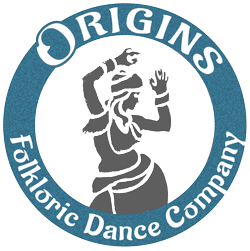(L - R) Rihanna, Ma'isah, and Angela perform a Tunisian dance. Photo by Dreamer's Realm Photography.
Repertoire
Below is a list of dances most frequently performed by Origins. See the description for choreographer and music credits. We are continually learning and adding new dances to our repertoire.
Egypt
Eiwa Aah
"The Coffee Grinder" choreography is flirtatious and fun, and depicts movements used by coffee merchants to grind coffee beans. Choreography by Mahmoud Reda. Music: "Eiwa Aah".Eskandarani
Inspired by a choreography by the late Ibrahim Farrah, this dance reflects the exuberant character of the Egyptian seaport of Alexandria. The dancers portray native Alexandrians who poke fun at European tourists. Music: “Eskanderani”, by Mustapha Omr.Fellahin
The fellahin are the farmers of Egypt. This playful dance portrays a group of young girls performing the typical everyday chore of collecting water in jugs. Original choreography by Sahra Saeeda, and adapted by Origins. Music: “Ala Warag Il Foul”, by Fatme Serhan.Hagallah
A dance from Western Egypt, named for the professional Bedouin dancers who are hired to help celebrate special events, such as weddings. Choreography by Mahmoud Reda. Music: “El Hagallah".Meleya Leff
The Meleya Leff is not a traditional folkloric dance; it was originally created by the great Egyptian choreographer Mahmoud Reda to capture the essence of Alexandria. The dance is named for the shawl used as a prop. Original choreography by Karen Kempskie-Aquino. Music: "Cocktail Iskandarany”, by Outi.Siwan
Siwa Oasis is one of Egypt's most isolated settlements, situated near the Libyan border. Its inhabitants are primarily Berbers. Choreography is by Katia of Boston, who was inspired on her visit to Siwa by familiar oasis sights: birds, palms, the bouncing and swaying donkey carts, and the playfulness of children. Music: “Benat al Waha”, by Aly Ismail.
Lebanon
Women's Dance
Morwenna Assaf's choreography is based on debkes performed by the Bedouins, a desert-dwelling Arabic ethnic group. Music: from Ziad Rahbani's Spectacular Rhythms of the Middle East.Cane Dance
The Lebanese version of the cane dance is derived from the Lebanese debke - it incorporates elements from debke dancing and has a little bit of a showoff quality to it. It is performed to music appropriate for debke, as opposed to saiidi or baladi music used for Egyptian-style cane dance. Choreography by Morwenna Assaf. Music: “Ya Ayn Moulayyiten”, by Alandelus.Lebanese Debke
A debke is a line and formation dance found in the Eastern Arabic countries known as the Levant (Lebanon, Syria, Jordan, Palestine, and Iraq), and is a communal dance done at most occasions and gatherings. There are dozens of variations, based on country and tribe. Choreography by Morwenna Assaf. Music: “Nissan el Amar”, by Samy Farag.Habibi Inta
This dance is Origins’ nod to classical Oriental dance done in Lebanese style, inspired by Ibrahim Farrah and choreographed by Morwenna Assaf. Music: “Habibi Enta”, by Bassil Moubayyed.Satouta
This elegant scarf dance is Morwenna Assaf's homage to Lebanese womanhood. Music: “Satouta”, by Sabah.
Morocco
Scarf Dance
A flirtatious and saucy choreography by Morwenna Assaf, inspired by La Meri. Music: “Raqs Araby”, by George Abdo.
Saudi Arabia and the Gulf
Khaleegy
Khaleegy is a traditional folkloric dance from the Persian Gulf, Arabic peninsula and the countries of Saudi Arabia, Kuwait, Oman, Bahrain, Qatar, and the United Arab Emirates. The name of the dance literally means “gulf” in Arabic and it is danced by local women at weddings and other social events. Kay Hardy Campbell's choreography, staged by Origins, invokes the vibrant energy of modern khaleegy dance in the context of traditional music. Music: “Ya Sariya Khabirini” (trad.), by Myriam Fares.
Sudan
Nubian
This dance is representative of the Nubians, a culture that originated in the area between Upper Egypt and the Sudan. The appearance of the Nubians, as well as the dance and music, are different from those in the rest of Egypt. The music is lively and the dance movements are casual and loose, with a strong African influence. Staged by Origins, the dance was choreographed by Morwenna Assaf, who was inspired by Mahmoud Reda's research. Music: “El Nouba”, from a compilation by Mahmoud Reda.Sudani
Morwenna Assaf's choreography reflects the influence of the different cultures that comprise the Sudan, including both Arabs and African tribes. Oriental hip movements combine with lively African-style gestures in this cheerful crowd-pleaser. The dancers wear colorful dresses to reflect the character of the region. Music: "Dance Sudani" by Eddie Kochak.
Tunisia
Tunisian
Tunisian dance, like that of other North African folk dance, is characterized by the horizontal forward and back movement of the hips. Dancers follow the beat of the drum with their hips. Choreography by Katia of Boston. Music: “Seif Dance”, by Tozeur Ensemble.
Turkey
- Konya
This modern choreography is characteristic of the lively and fun folk dances of Turkey. Konya is a major city in the Central Anatolia region of Turkey. Choreography by Karen Kempskie-Aquino. Music: "Konya".
- Tambourine
Origins learned this dramatic, upbeat, and spirited choreography from the Turkish dancer and teacher Neheda. Choreography by Neheda. Music: "Fire of Anatolia".
